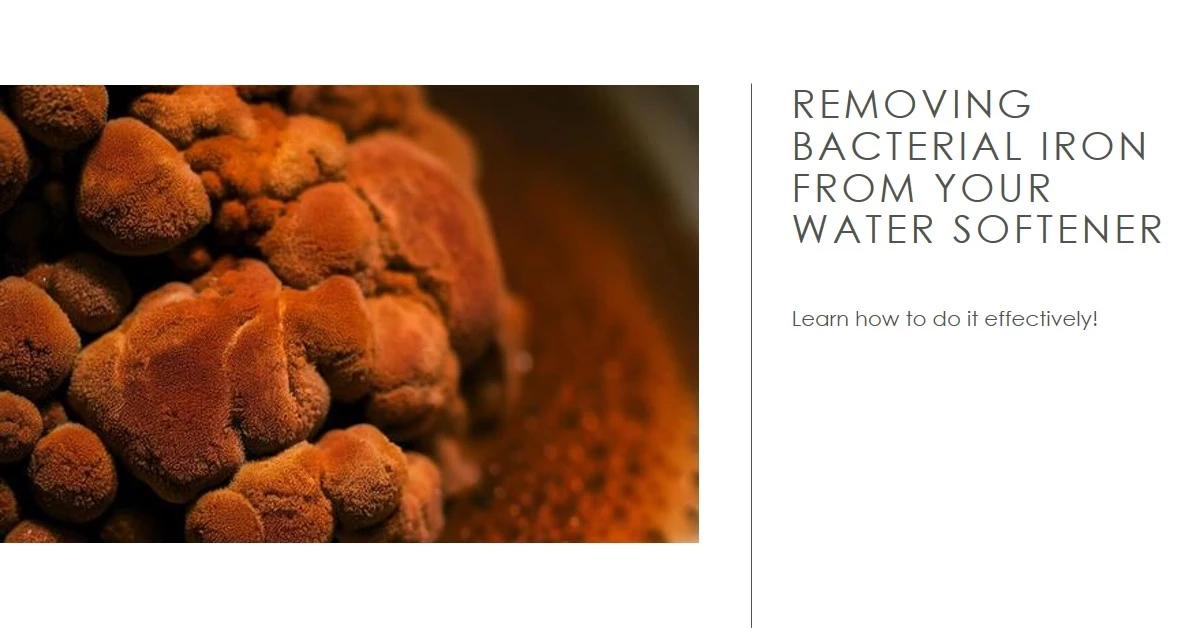Removing bacterial iron from your water softener is essential for maintaining high-quality water and a healthy home environment. This comprehensive guide will cover various methods and best practices to help you achieve better water quality while addressing potential pitfalls.
Understanding Bacterial Iron in Well Water
Bacterial iron in well water can negatively impact water quality and health. To tackle this issue effectively, let’s explore the causes and signs of bacterial iron contamination:
Causes of bacterial iron in well water
- Naturally occurring iron bacteria in groundwater
- Contamination from external sources, such as runoff or leaking pipes
Signs of bacterial iron contamination
- Reddish-brown stains on fixtures and appliances
- Unpleasant tastes or odors in the water
- Clogging of pipes and fixtures
Identifying the Type of Iron in Your Water
It’s crucial to determine the type of iron present in your water to effectively remove it.
Testing water for iron bacteria
- Conduct a water analysis to identify bacterial iron and other contaminants
- Use a water testing kit or hire a professional service
Understanding the difference between bacterial iron and other forms of iron
- Bacterial iron: Caused by iron bacteria, which oxidize dissolved iron, resulting in a slimy, reddish-brown deposit
- Ferrous iron: Dissolved iron that is soluble and invisible in water
- Ferric iron: Insoluble iron that appears as visible particles in water
Methods for Removing Bacterial Iron from Well Water
There are several effective methods for removing bacterial iron from well water. However, it’s crucial to consider their potential drawbacks:
- Oxidizing filters: These filters use a process called oxidation to convert soluble iron into insoluble particles, which are then filtered out. However, they may require regular maintenance and filter replacements.
- Chlorination: Adding chlorine to well water kills iron bacteria and oxidizes ferrous iron. Nonetheless, it can result in unpleasant chlorine taste and smell in the water.
- Aeration: Injecting air into the water helps oxidize iron and kill iron bacteria. This method may require additional equipment and regular maintenance.
- Ozone injection: Ozone is a powerful oxidant that can destroy iron bacteria and oxidize iron. However, ozone systems can be costly and require professional installation.
- Potassium permanganate: This chemical oxidizes iron and kills iron bacteria but should be used with caution due to potential health risks and staining.
Choosing the Right Water Softener for Iron Removal
Selecting the right water softener is crucial for effectively removing bacterial iron. Make sure to weigh the pros and cons of different systems.
Factors to consider when selecting a water softener
- Water hardness
- Iron content
- pH levels
- Water usage
Types of water softeners effective against bacterial iron
- Ion exchange water softeners
- Water softeners with iron reduction filters
How to Maintain Your Water Softener for Iron Removal
Regular maintenance is vital for the longevity and effectiveness of your water softener. However, avoid common mistakes that can lead to poor performance.
- Regular backwashing: Flush the system periodically to remove accumulated iron particles, but don’t overdo it, as excessive backwashing can waste water.
- Flushing the system and resin bed with Rust Out: This helps protect the system and prolong the life of the resin beads. Follow the manufacturer’s instructions to avoid potential issues.
- Monitoring water hardness and pH levels: Regularly test your water to ensure optimal performance. Keep a record of the results to track any changes over time.
Additional Filtration Systems to Improve Water Quality
To further improve water quality, consider implementing additional filtration systems:
- Sediment filters: Remove larger particles and debris from water
- Iron reduction filters: Specifically designed to target and remove iron
- Multi-stage filtration systems: Combine various filtration methods for optimal results
Tips for Preventing Bacterial Iron Buildup in Your Water Softener
Prevent bacterial iron buildup by following these tips:
- Regular water testing and analysis
- Proper well pump maintenance
- Monitoring water pressure and flow rate
The Importance of Regular Water Softener Maintenance
Scheduled maintenance tasks and identifying signs of iron fouling can help keep your water softener functioning optimally.
Scheduled maintenance tasks
- Inspect and clean the brine tank regularly
- Replace filters and filtration media as needed
- Periodically sanitize the system with a disinfectant
Identifying signs of iron fouling
- Reduced water pressure
- Frequent need for backwashing
- Changes in water taste or smell
Troubleshooting common issues
- Flush the system to remove iron buildup
- Check for and repair any leaks
- Consult a professional if problems persist
Key Takeaways
Removing bacterial iron from your water softener is crucial for maintaining high-quality water and a healthy home environment. By following the methods and best practices outlined in this guide, you can effectively eliminate bacterial iron and ensure your water softener functions optimally. Regular maintenance and monitoring of your water softener system will help prevent future issues and provide peace of mind for you and your family.
Related Articles:
How to Replace the Water Filter in Your Water Softener?
How Does a Water Softener Affect a Septic Tank?



